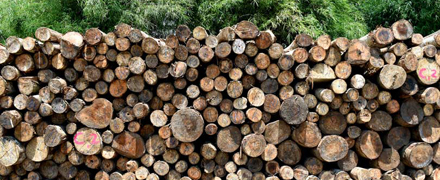 Sweden’s forest industries have the capability to produce high-quality, high-margin wood products in large part due to access to quality wood raw materials. Like all forest economies, the raw material supply plays a crucial role in the forest industry’s long-term success and ability to manage sustainable growth. Recent developments in the domestic raw material base show that supply risks are always present. Source: Forest2Market
Sweden’s forest industries have the capability to produce high-quality, high-margin wood products in large part due to access to quality wood raw materials. Like all forest economies, the raw material supply plays a crucial role in the forest industry’s long-term success and ability to manage sustainable growth. Recent developments in the domestic raw material base show that supply risks are always present. Source: Forest2Market
According to the Swedish Forest Agency, the total harvest level increased by almost 20 million cubic meters (m³) from 1999-2018; from 72 million m³ to 92 million m³. The growing harvest level reflects the increasing raw material demand from wood-consuming industries over a nearly 20-year period.
Current harvest data suggests Sweden is close to its peak sustainable harvesting level, which the Swedish Forest Agency estimates is in the range of 95-100 million m³.
This very tight supply/demand situation can also be found in neighbouring Finland, although its gap between current harvests and sustainable maximum levels is slightly larger. However, it must be noted that the supply/demand balance in Finland varies regionally and between wood assortments and types.
Finnish demand is expected to increase in the near term as there are several greenfield pulp mill plans on the horizon.
To further stress Sweden’s supply/demand dynamic, the supply of wood raw material has recently experienced unforeseen damage due to major forest fires, which broke out throughout the country in the summer of 2018. These fires had a significant impact on the forest supply chain and production capabilities, as large volumes of salvage harvests were necessary.
As a result, the total harvest area in 2018 was its largest since 1995, and manufacturers are still working through inventories of roundwood salvaged from the fires, which impacts final-product quality.
Prolonged storage times also increase the risk of exposing the wood to various fungi and insect damage. As a result of this situation, the Swedish Forest Agency reported a steep increase in roundwood prices from roadside sales, which is likely the result of increased demand of fresh wood.
Pulpwood prices rose 13% compared with 2017, which is the largest increase since 2008. Every quarter of the year showed prices increase in comparison to the corresponding quarter in 2017.
Sawlog prices increased 7% during 2018 in comparison to 2017, which is the largest increase since 2010.
Swedish forests are producing enough annual volume to meet current capacity, but there is very little room for growth in the domestic raw material supply, and any growth alternative must come from raw material imports. Currently, less than 10% of wood raw materials are imported; however, there are signs that the Swedish pulp and bioenergy sectors are increasing import volumes, especially from the Baltic countries.
Next door, Finnish manufacturers have also increased their share of imports from many of the same countries, which has caused sharp price increases. These developments are representative of the intensifying competition for wood raw materials throughout the Baltic Rim, which also impacts Swedish wood-consuming industries.
Furthermore, Swedish producers will also be impacted by activities overseas; low-cost sawmill capacity is increasing significantly in the US South and these manufacturers will compete with Swedish sawnwood exporters in the US as well as in the Middle East and North Africa (MENA) region.





